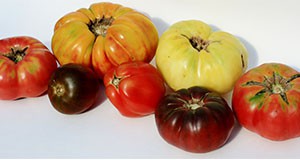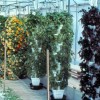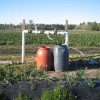Fusarium wilt of watermelon is one of the most serious and difficult diseases to manage and occurs in most production regions worldwide. The fungus can be seedborne and has great longevity in the soil, allowing infested soil to also serve as a source of infection. This new 4-page publication of the UF/IFAS Plant Pathology Department signs, symptoms, and the disease cycle of Fusarium wilt and provides recommendations for cultural and chemical management. Written by Pamela Roberts, Nicholas Dufault, Robert Hochmuth, Gary Vallad, and Mathews Paret.
https://edis.ifas.ufl.edu/pp352
Tag: Robert C. Hochmuth
Leafy Greens in Hydroponics and Protected Culture for Florida

Leafy greens are some of the top “powerhouse” fruits and vegetables. They are also becoming increasingly more popular for consumers. This seven-page fact sheet is designed to aid Florida hydroponic and/or other protected culture growers who are seeking appropriate cultivars of the leafy greens group. The article covers spinach, Swiss chard, kale, collard greens, mustard greens, and Asian greens. Written by Natalie B. Parkell, Robert C. Hochmuth, and Wanda L. Laughlin and published by the Horticultural Sciences Department.
http://edis.ifas.ufl.edu/hs1279
Water and Nutrient Management Guidelines for Greenhouse Hydroponic Vegetable Production in Florida

Many small farms are implementing greenhouse hydroponic systems. Perhaps the most challenging aspect of crop management for smaller growers is the control of water and nutrient delivery in a soilless media system. This six-page fact sheet focuses on relatively inexpensive strategies to help small growers know both when to start irrigation events and how long to run a single event when growing in soilless media. Written by Robert C. Hochmuth, Natalie B. Parkell, Wanda L. Laughlin, and Sean C. Rider, and published by the Horticultural Sciences Department.
http://edis.ifas.ufl.edu/hs1274
Tomato Cultivar Selection Considerations for Open-Field and Protected Culture in North Florida

Tomatoes represent one of the most popular vegetables grown in protected culture such as greenhouses, high tunnels, or shade houses. Selecting the correct cultivar of tomato is critical and varies depending on the intended season, type of protected structure, training system, expected insect and disease pressure, post-harvest handling techniques, and intended market. This seven-page fact sheet will focus on the key factors affecting the cultivar selection decisions for growing and selling tomatoes in north Florida. Written by Blake R. Thaxton and Robert C. Hochmuth, and published by the Horticultural Sciences Department.
http://edis.ifas.ufl.edu/hs1273
Selecting Cultivars of Lettuce For Production Using Hydroponics and Protected Culture in Florida
 With correct variety selection and protected culture strategies, lettuce is a crop that can present even the novice grower with a fast-growing commodity for market sale. Includes brief descriptions of hydroponic lettuce production systems, cultivars, and a table summarizing the lettuce types successfully grown in Florida using protected agriculture and hydroponic techniques. This 6-page fact sheet was written by Natalie B. Parkell, Robert C. Hochmuth, and Wanda L. Laughlin, and published by the UF Department of Horticultural Sciences, March 2015. (Photo: UF/IFAS)
With correct variety selection and protected culture strategies, lettuce is a crop that can present even the novice grower with a fast-growing commodity for market sale. Includes brief descriptions of hydroponic lettuce production systems, cultivars, and a table summarizing the lettuce types successfully grown in Florida using protected agriculture and hydroponic techniques. This 6-page fact sheet was written by Natalie B. Parkell, Robert C. Hochmuth, and Wanda L. Laughlin, and published by the UF Department of Horticultural Sciences, March 2015. (Photo: UF/IFAS)
http://edis.ifas.ufl.edu/hs1258
Characterization of the Florida Fresh Fruit and Vegetable Industry Using Hydroponic Systems or Protected Agriculture Structures
 UF/IFAS Extension faculty, allied industry representatives, and growers determined the need to assess the size and scope of the protected agriculture industry in 2013 by surveying growers in Florida. The primary focus was to document the types of protected agriculture structures, crops, and growing systems being used. In addition, secondary information on location of operations, pest concerns, expected expansion, etc. was collected on many operations. The results documented a significant expansion of the industry in terms of both size and scope. This 8-page fact sheet was written by Robert C. Hochmuth and Dilcia E. Toro, and published by the UF Department of Horticultural Sciences, August 2014.
UF/IFAS Extension faculty, allied industry representatives, and growers determined the need to assess the size and scope of the protected agriculture industry in 2013 by surveying growers in Florida. The primary focus was to document the types of protected agriculture structures, crops, and growing systems being used. In addition, secondary information on location of operations, pest concerns, expected expansion, etc. was collected on many operations. The results documented a significant expansion of the industry in terms of both size and scope. This 8-page fact sheet was written by Robert C. Hochmuth and Dilcia E. Toro, and published by the UF Department of Horticultural Sciences, August 2014.
http://edis.ifas.ufl.edu/hs1240
Veggies and Herbs: Made in the Shade A Growing Season Calendar for North Florida
 The importance of using an open shade structure for hydroponic crop culture in Florida has recently increased. Prior to the turn of the century, hydroponic culture in Florida was done inside a greenhouse structure, but it has now expanded to several other types of structures. In addition to greenhouses, production now exists in high tunnels, insect screens or net houses, and open shade-covered structures. In southern parts of Florida, outdoor hydroponic systems without any structure are becoming more common. In those cases, many operations use a polypropylene cover for freeze protection. Diversifying structures stems from growers’ desires to extend the season to meet consumer demand for a longer time period. The purpose of this publication is to indicate what crops have been successfully grown under shade in northern Florida at various times of the year. This 4-page fact sheet was written by Daniel K. Fenneman, Robert C. Hochmuth, Wanda L. Laughlin, and Sean R. McCoy, and published by the UF Department of Horticultural Sciences, November 2014.
The importance of using an open shade structure for hydroponic crop culture in Florida has recently increased. Prior to the turn of the century, hydroponic culture in Florida was done inside a greenhouse structure, but it has now expanded to several other types of structures. In addition to greenhouses, production now exists in high tunnels, insect screens or net houses, and open shade-covered structures. In southern parts of Florida, outdoor hydroponic systems without any structure are becoming more common. In those cases, many operations use a polypropylene cover for freeze protection. Diversifying structures stems from growers’ desires to extend the season to meet consumer demand for a longer time period. The purpose of this publication is to indicate what crops have been successfully grown under shade in northern Florida at various times of the year. This 4-page fact sheet was written by Daniel K. Fenneman, Robert C. Hochmuth, Wanda L. Laughlin, and Sean R. McCoy, and published by the UF Department of Horticultural Sciences, November 2014.
http://edis.ifas.ufl.edu/hs1228
Directory of Certified Deciduous Fruit and Nut Crops in Florida
 This 8-page fact sheet written by experts at North Florida REC Peter C. Andersen, Robert C. Hochmuth, Sean R. McCoy, and Lei Lani L. Davis, assists farmers in locating recommended cultivars of fruit and nut crops from Florida nurseries. The nurseries listed in Table 1 offer fruit and nut trees and are listed as certified nurseries with the Florida Department of Agriculture and Consumer Services. Table 2 lists fruit and nut cultivars that UF/IFAS Extension specialists currently recommend or suggest on a trial basis. Published by the UF Department of Horticultural Sciences, April 2013.
This 8-page fact sheet written by experts at North Florida REC Peter C. Andersen, Robert C. Hochmuth, Sean R. McCoy, and Lei Lani L. Davis, assists farmers in locating recommended cultivars of fruit and nut crops from Florida nurseries. The nurseries listed in Table 1 offer fruit and nut trees and are listed as certified nurseries with the Florida Department of Agriculture and Consumer Services. Table 2 lists fruit and nut cultivars that UF/IFAS Extension specialists currently recommend or suggest on a trial basis. Published by the UF Department of Horticultural Sciences, April 2013.
http://edis.ifas.ufl.edu/hs1218
Construccion de Sistema Hidroponico Flotante (HS1210)
 Los aztecas maravillaron a los conquistadores españoles con sus huertos flotantes, y hoy, 500 años después, usted puede impresionar a sus amigos y vecinos con el suyo. This 4-page fact sheet was written by Horticultural Sciences, and published by the UF Department of J. Bosques, M. Sweat, R. Tyson, y R. Hochmuth, January 2013.
Los aztecas maravillaron a los conquistadores españoles con sus huertos flotantes, y hoy, 500 años después, usted puede impresionar a sus amigos y vecinos con el suyo. This 4-page fact sheet was written by Horticultural Sciences, and published by the UF Department of J. Bosques, M. Sweat, R. Tyson, y R. Hochmuth, January 2013.
http://edis.ifas.ufl.edu/hs1210
Production Systems: Florida Greenhouse Vegetable Production Handbook, Vol 3 (HS785/CV263)
 Worldwide, commercial greenhouse vegetable producers currently use numerous production systems. Among the more prevalent include lay-flat bag or upright container culture, trough culture, rockwool, vertical culture, nutrient film technique (NFT), and ground (in-soil) culture. Many modifications of these basic production systems are presently in use, and most are appropriate for Florida, except for unamended ground culture. This 8-page fact sheet was written by Dan Fenneman, Michael Sweat, George Hochmuth, and Robert Hochmuth, and published by the UF Department of Horticultural Sciences, October 2012.
Worldwide, commercial greenhouse vegetable producers currently use numerous production systems. Among the more prevalent include lay-flat bag or upright container culture, trough culture, rockwool, vertical culture, nutrient film technique (NFT), and ground (in-soil) culture. Many modifications of these basic production systems are presently in use, and most are appropriate for Florida, except for unamended ground culture. This 8-page fact sheet was written by Dan Fenneman, Michael Sweat, George Hochmuth, and Robert Hochmuth, and published by the UF Department of Horticultural Sciences, October 2012.
http://edis.ifas.ufl.edu/cv263
Alternative Greenhouse Crops: Florida Greenhouse Vegetable Production Handbook, Vol 3 (HS791/CV272)
 In 2012, it was estimated that 500 acres or more of all edible crops were being grown in some type of protected culture in Florida. This 13-page fact sheet discusses some of the alternative or specialty crops being grown and marketed. Written by R. Hochmuth and D. Cantliffe, and published by the UF Department of Horticultural Sciences, October 2012.
In 2012, it was estimated that 500 acres or more of all edible crops were being grown in some type of protected culture in Florida. This 13-page fact sheet discusses some of the alternative or specialty crops being grown and marketed. Written by R. Hochmuth and D. Cantliffe, and published by the UF Department of Horticultural Sciences, October 2012.
http://edis.ifas.ufl.edu/cv272
Fertigation for Vegetables: A Practical Guide for Small Fields (HS1206)

More and more farmers are growing small crops of fruits and vegetables for specialty local markets. They commonly grow several crops at different stages of development at the same time so they have a variety of produce to sell to customers. This forces farmers to make several fertilizer calculations because of their diverse crop demands, because water and nutrient requirements vary according to the crop and stage of development. This 7-page fact sheet helps growers correctly interpret fertilizer recommendations and calculate accurate fertilizer amounts to be used based on crop nutrient requirements. Written by Jim DeValerio, David Nistler, Robert Hochmuth, and Eric Simonne, and published by the UF Department of Horticultural Sciences, October 2012.
http://edis.ifas.ufl.edu/hs1206
HS798/CV274 Vegetable Insect Identification and Management – Florida
Revised! HS798, a 24-page guide by S. E. Webb and R. C. Hochmuth, provides instruction in management and control of insects and mites in greenhouse vegetable production — crop scouting and monitoring, identification of insects and mites, record keeping, management strategies and tactics, banker plant system, insecticides and miticides, storage of pesticides, safety, and control of specific greenhouse pests. Includes references. Published by the UF Department of Entomology and Nematology, June 2010.
http://edis.ifas.ufl.edu/cv274
HS1164 Microgreens: A New Specialty Crop
HS1164, a 3-page illustrated fact sheet by Danielle D. Treadwell, Robert Hochmuth, Linda Landrum, and Wanda Laughlin, provides an overview of this new type of market crop and its production. Includes references. Published by the UF Department of Horticultural Sciences, May 2010.
http://edis.ifas.ufl.edu/hs1164
SL293/SS506 Using Composted Poultry Manure (Litter) in Mulched Vegetable Production
SL-293, a 9-page illustrated fact sheet by George Hochmuth, Robert Hochmuth, and Rao Mylavarapu, answers vegetable producers’ questions about what poultry manure and litter are, what plant nutrients they contain, considerations for using them, results of research in Florida, how to use it in a mulched-bed system, and how to collect and submit for testing poultry manure samples. Includes references. Published by the UF Department of Soil and Water Science, October 2009.
http://edis.ifas.ufl.edu/SS506
WC088 Characteristics of Small Farm Operators in Florida: Economics, Demographics, and Preferred Information Channels and Sources
WC088, an 11-page illustrated report by Steven A. Gaul, Robert C. Hochmuth, Glenn D. Israel, and Danielle Treadwell, summarizes the results from the 2008 University of Florida IFAS Extension–Florida Agricultural and Mechanical University (FAMU) Small Farm Survey. This information can then be used by Extension faculty to identify target audiences, develop relevant materials, and deliver this information through appropriate channels to assist farmers in achieving the goals of their small farm enterprises. Includes references. Published by the UF Department of Agricultural Education and Communication, July 2009.
http://edis.ifas.ufl.edu/WC088
HS1155 Production and Marketing of Chestnuts in the Southern United States
HS-1155, a 9-page illustrated fact sheet by Robert C. Hochmuth, Robert D. Wallace, Peter J. Van Blokland, and Jeffrey G. Williamson, provides information about these species of the beech family, which could make a viable alternative crop for small farmers in Florida who are looking to diversify their operations — history, economics, species and hybrids, nut quality and grades, propagation, location and site, orchard planting and production, pruning, pest management, pollination and nut formation, harvesting and storage, processing, marketing, and nutrition. Published by the UF Horticultural Sciences Department, July 2009.
http://edis.ifas.ufl.edu/HS1155
SL284/SS497 Blossom-End Rot in Bell Pepper: Causes and Prevention
SL-284, a 5-page illustrated fact sheet by George J. Hochmuth and Robert C. Hochmuth, describes one of the most commonly observed disorders of pepper, blossom-end rot (BER) — its symptoms, calcium physiology, calcium deficiency, factors predisposing fruits to BER, and prevention. Includes references. Published by the UF Department of Soil and Water Science, April 2009.
http://edis.ifas.ufl.edu/SS497
HS1020/HS255 Greenhouse Manufacturers and Suppliers
Revised! HS-1020, a 6-page fact sheet by George J. Hochmuth and Robert C. Hochmuth, provides a partial directory of greenhouse manufacturers and suppliers. Published by the UF Department of Horticultural Sciences, February 2009.
http://edis.ifas.ufl.edu/HS255
ENY-846/IN730 Exclusion Methods for Managing Greenhouse Vegetable Pests
ENY-846, a 4-page illustrated fact sheet by R.C. Hochmuth and R.K. Sprenkel, lists several insect pest exclusion techniques for greenhouse vegetable producers in Florida. Includes references. Published by the UF Department of Entomology and Nematology, April 2008.
http://edis.ifas.ufl.edu/IN730
